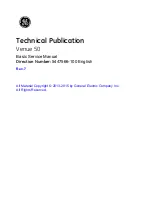
Instruction Manual VET LIFT
Page 19 of 27
Version 2.02
Never use steel wool or steel brushes, as otherwise micro particles could penetrate the
surface of the stainless steel top and cause corrosion. If necessary, only use nylon or other
plastic brushes.
To remove calcium deposits or such limestones, preferably use vinegar and subsequently
rinse the surface with clean water. Afterwards, the surface of the plate should be wiped dry
with a soft cloth.
Avoid extended contact of halogen-containing substances (chlorine, bromine, iodine) and
thiocyanate with the stainless steel surface. Prolonged contact or drying of salty solutions
may also cause discoloration or corrosion.
The use of various PVC plastic mats as underlays is also not recommended. Heat exposure
in some operating lights can cause chlorides to escape, which in turn may come into contact
with the stainless steel plate and lead to discoloration or corrosion of the latter.
Regular cleaning with water and "mild" detergents as well as subsequent rubbing dry with
soft cloths has proven to be the ideal way to care for stainless steel plates. In this context,
one should bear in mind that there is no such thing as a completely corrosion-free stainless
steel plate, in whatever alloy form, so far.
The use of additional protective coating in the form of varnish or paint is also strongly
discouraged. Engravings of names or other carved information on the stainless steel plate
will immediately lead to surface corrosion.
New stainless steel table tops usually have a flawless surface. Only on a brand new table top
you will be able to notice a scratch immediately. However, it should be mentioned at this
point that already after a very short time there will be so many, smaller scratches that the
overall appearance will be accepted as such.
Cleaning synthetic top
A "mild" disinfectant (e.g. kitchen detergent) is sufficient for cleaning the synthetic top. The
entire surface of the plate should be rinsed frequently with clear water and wiped dry.
Residues such as blood or urine should be able to be removed with soap and water. In the
case of stubborn residues, it may be necessary to use a suitable brush in conjunction with a
special cleaner.
To remove calcium deposits or such limestones, one should preferably use vinegar and then
rinse the surface with clean water. Wipe dry with a soft cloth.
Regular cleaning with water and "mild" detergents as well as subsequent dry rubbing with
soft cloths has proven to be the ideal care for synthetic tops.
Never use steel wool or steel brushes. If necessary, use nylon or other plastic brushes only.
A weekly cleaning with a special synthetic cleaner is recommended. Contact your local
distributor for this product.
Содержание VET LIFT 7H9.6P1
Страница 14: ...Instruction Manual VET LIFT Page 14 of 27 Version 2 02 ...
Страница 15: ...Instruction Manual VET LIFT Page 15 of 27 Version 2 02 ...
Страница 16: ...Instruction Manual VET LIFT Page 16 of 27 Version 2 02 ...
Страница 21: ...Instruction Manual VET LIFT Page 21 of 27 Version 2 02 ...
Страница 22: ...Instruction Manual VET LIFT Page 22 of 27 Version 2 02 ...









































